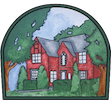
The University District is a community with historical Tudor and colonial style homes on tree lined streets. Most of the trees in our neighborhood are just as old as the homes. It tends to be obvious when our homes are in need of maintenance and we typically take action to make the necessary repairs. The maintenance and/or repair of our trees on the other hand can be more challenging to determine. Although it may not be on our radar in the same way home repair and maintenance is, a similar approach should be taken when it comes to caring for our trees. Many times, it’s only when a tree looses a large branch that we take notice.
It is common to suddenly be concerned about a tree. The thought of a tree losing a large branch or event tipping over onto our homes, garages and cars can evoke fear. The go to response might be “we need this tree removed”. Before you determine if a tree needs to be cut down, consider first consulting an ISA Certified Arborist. An arborist has the professional training to access the health of the tree. Tree risk ratings can be provided by a ISA Tree Risk Assessment Qualified (TRAQ) Arborist.
Common remedies recommended can be as simple as removing the decorative hosta along the base of the tree and/or the English ivy growing on the tree. Pruning healthy branches and trimming the dead ones is an important part of regular tree maintenance. You may also consider planting another tree nearby a weak or unstable tree to secure it’s root system. According to Emily Brent, ISA Certified Arborist from Singing Tree, “flower beds around tree bases are not recommended.” Neither are ”chemical lawn treatments for the health of nearby trees, pets and humans” Emily says.
In the older neighborhoods with mature trees that have multiple dead branches, moving excess soil from the base of the tree, a process known as root crown excavation” is most commonly recommended by Arborists. For this reason, “building up the soil around the tree base in not recommended”. This is considered a health and wellness technique.
Recommend trees are assessed every 3-5 years. #1 making sure the trees are well cared for and maintained and it also serves as a cost reduction measure. You may be surprised to learn that tree trimming many species of trees in fall and winter when they are dormant safeguard them from spreading infection and disease.
By hiring an arborist, you may not only save your tree, but also the birds and hundreds of other species that nest, eat and seek shelter from predators in your trees. Trees tend to lower summer temperatures by providing shade and provide a natural method of removing carbon dioxide from the environment. Trees also create a natural noise buffer.
Brittany Leick, Program Coordinator, from Detroit Audubon shares that “Oak Trees can support over 500 species of butterflies and moths which serve as food for birds. Ninety five percent of birds need insects to feed their young.” She adds “A healthy ecosystem incorporates native plants and trees which sustain insects attracting and maintaining the bird population”.
Lean more about the relationship between trees and birds at an upcoming Detroit Audubon event: Trees Are For The Birds Webinar, Tuesday May 10th, 2022 from Noon-1pm.
Article by Leslie Graves and Deborah Burke.
